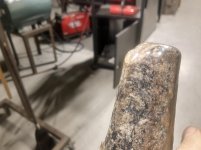AdamPrince2
Plastic
- Joined
- May 10, 2011
- Location
- Honeoye Falls, NY
I have provided a link to the very rare spark testing book that it out of copy right due to non renewal of rights and age. The book is called The Spark Atlas by Gerhart Tschorn 1963. Maybe someone can cleanup the pdf. I have an antique hammer that I am trying to identify the steel so I can weld a large chip. The spark pattern looks very bright and full of star bursts and sprigs. I compared it to cold rolled. What type of steel is it?




Upload files for free - The Spark Atlas.pdf - ufile.io




Upload files for free - The Spark Atlas.pdf - ufile.io





